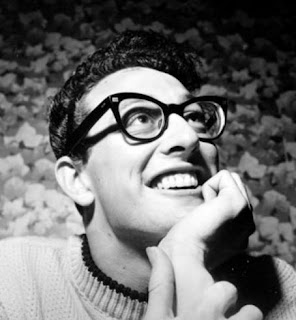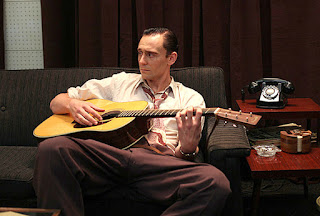Tickets are on sale now for Buddy - The Buddy Holly Story - when it comes to E.J. Thomas Hall, January 12-13, as part of the 2015-2016 Broadway in Akron series. The show that inspired a generation of multi-million selling juke-box musicals starts a 9 week tour of the USA on Monday, January 4th, 2016. Loved by critics and audiences alike, Buddy tells the enduring tale of the musical icon's meteoric rise to fame and his final legendary performance at the Surf Ballroom in Clear Lake, Iowa, before his tragic and untimely death at the age of 22.
Buddy's widow, Maria Elena Holly, says of the show: "When we opened the show we never imagined Buddy's music and story would still be rocking stages and entertaining audiences around the world week-in week-out over 25 years later. I believe this is testament to a great show - the first of its kind - and to the enduring appeal of Buddy Holly and what he represents; a youthful energy, huge talent and creativity, combined with a determination to make a lasting impression in this world." Source: www.broadwayworld.com
Buddy Holly learned to play the piano and violin as a youngster. He went barefoot in the summer, rabbit hunting in the fall, and liked to read comic books, adventure stories, or science fiction. Holly was elected king of the sixth grade at Roosevelt School.
One of the most commonly asked questions of the 1950s was “What will you do when rock ‘n’ roll dies?” Colonel Parker brought Elvis incredible fame and wealth, while Buddy’s manager held him back and stole a fortune from him. While 1956 would turn out to be a spectacular breakout year for Elvis, for Buddy it was a year of failure and exploitation that would test his resolve to make it as a professional entertainer.
In RCA’s Nashville studio on January 10, Elvis recorded “Heartbreak Hotel,” which would reach the top of Billboard’s pop chart in May, launching Presley’s fabulous run through the end of the decade. Meanwhile, Buddy’s Nashville Decca session on January 26 was a disaster. “It’s a wonder the world ever again heard of Buddy Holly,” Amburn noted. Buddy’s second release for Decca also failed miserably, and at year’s end the label declined to renew his contract. As 1957 dawned, Buddy was penniless, his career no further along than it had been 12 months before.
In RCA’s Nashville studio on January 10, Elvis recorded “Heartbreak Hotel,” which would reach the top of Billboard’s pop chart in May, launching Presley’s fabulous run through the end of the decade. Meanwhile, Buddy’s Nashville Decca session on January 26 was a disaster. “It’s a wonder the world ever again heard of Buddy Holly,” Amburn noted. Buddy’s second release for Decca also failed miserably, and at year’s end the label declined to renew his contract. As 1957 dawned, Buddy was penniless, his career no further along than it had been 12 months before.
By the time “That’ll Be the Day” became Buddy’s first hit record, Elvis already had five #1 singles and eight gold records. In January 1957, without a manager, a band, or a recording contract, Buddy returned to Lubbock and considered quitting the music business. Deciding to give it one more try, he formed another band and drove ninety miles northwest of Lubbock to record at Norman Petty’s recording studio in Clovis, New Mexico. There, on February 24, 1957, Holly’s life changed when he recorded a rocking version of “That’ll Be the Day.” Source: www.elvis-history-blog.com
Just before Christmas 1958, Buddy had hoped to resume his relationship with Echo McGuire, who would be home for the holidays during her school break. But McGuire had a new boyfriend. “I told Buddy what I had decided,” Echo says. “From that point on, I put him aside.” While waiting for the release of “That’ll Be the Day,” Holly helped lay tile with his brothers. Holly also helped Norman Petty build an echo chamber for his studio, in the attic above Petty’s father’s service station. On the deepest level of his life Buddy was troubled and unfulfilled. Like many in his circle, he was headed for misfortune. For Buddy, life on the road offered no opportunity for meeting the kind of girl he wanted to marry. Buddy, the young man who genuinely loved “good girls,” found such girls even tougher to meet as a famous rocker.
Buddy Holly’s “Peggy Sue” hit the one-million mark in sales the same day Alan Freed’s Christmas show debuted at the Paramount Theater near Times Square on December 27. While in New York, Holly and the Crickets made their first television appearance on the Arthur Murray Show on December 28, performing “Peggy Sue.” When the band arrived backstage before the show, Holly & The Crickets mingled with the starstudded cast, which included Tallulah Bankhead, June Havoc, Gloria DeHaven, jazz singer Sarah Vaughan, and screen-siren Hedy Lamarr. Rock ’n’ roll was civilization’s wake-up call, and its pioneers, like James Joyce’s Stephen Dedalus, were forging in the smithy of their souls “the uncreated conscience” of their race. But its immediate future in 1958 was rife with so much hatred and hostility from society that it’s remarkable that rock ’n’ roll managed to survive at all.
‘Raining In My Heart’, ‘Moondreams’ and ‘True Love Ways’ were slow, reflective ballads, without a hint of beat, and Buddy sang them completely ‘straight’, banishing all clicks and hiccups from his voice, drawing only on its warmth, its conviction, its gentleness, its ability to address the listener personally. Buddy's mother, Ella, picked ‘True Love Ways’ as the stand-out track, though even she did not dream what an imperishable standard it would become. Written ostensibly for and about Maria Elena, its stupendous charm lies in its mixture of intimacy and universality. While speaking directly and uniquely to Maria Elena, it is also a message to ‘all those who really care’, as ever counselling patience, hope and trust in the benignity of Fate. Maria Elena tried to cook for the musicians: “She about killed us cooking,” Waylon Jennings says. “She tried to cook beans and burned them. Can you imagine burning beans? Buddy said, ‘Don’t say anything. Just eat them.’”
Buddy and Maria Elena found an apartment in New York in Greenwich Village, on Fifth Avenue. Buddy designed cabinets for the kitchen as well as a bar that opened out onto the terrace. If he couldn’t make it as a singer, he told his wife, he could always earn a living as a draftsman or engineer. Ella had always been proud of how skilled and resourceful Buddy was, how he could fix anything that went wrong around the house. —"Buddy Holly: A Biography" (2014) by Ellis Amburn.
Sharon Sheeley (Eddie Cochran's fiancé) wrote in her memories: "Buddy Holly was terribly shy; he tended to complicate his alienation because of his extreme shyness, his self-consciousness about his 'homely' looks. Buddy not only knew rock 'n' roll would last, he also understood it had to evolve over time. Buddy was our superior from a musical theory aspect. —"Summertime Blues: A True Rock 'n' Roll Adventure with Eddie Cochran" (2010) by Sharon Sheeley
On Friday, 30 January, the ‘Winter Dance Party’ chasséed down the frozen highway to play the Laramar Ballroom in Fort Dodge, Iowa. Rock stars of today would not put up with such conditions for five minutes. But rock stars of 1959 were an infinitely hardier, more philosophical breed. Maria Elena had to break it to Buddy that, after almost four weeks, there still was no sign of ‘It Doesn’t Matter Anymore’ in Billboard’s Hot 100. Buddy made a brave show of not being worried, telling her it would probably turn out to be another ‘sleeper’ like ‘That’ll Be The Day’. But inwardly he resigned himself to having missed yet again. That night, close to despair, he called his friend Eddie Cochran, who was recording in the enviable warmth of California. ‘Eddie came back from the phone really concerned,’ Cochran’s girlfriend, Sharon Sheeley, remembers. ‘He said “Buddy’s so down, he thinks it’s all over in the charts for him. I told him, don’t be a fool. You’re the best there is. You’ll be back up there again soon.” ’
Even with Buddy dead, however, Norman Petty continued to find reasons not to pay. Maria Elena was obliged to leave the gentlemanly Orenstein and seek more aggressive legal representation, whereupon Petty finally disgorged what his books said he owed Buddy and what Maria Elena now describes as ‘a paltry sum’, just over $35,000. Paltry or not, it would have made the difference between struggling through the Midwest on a second-rate tour or staying safe and warm in the Brevoort building, among the hippies and coffee-houses. It was enough, in every sense, to have kept Buddy alive. —"Rave On: The Biography of Buddy Holly" (2014) by Philip Norman
























































